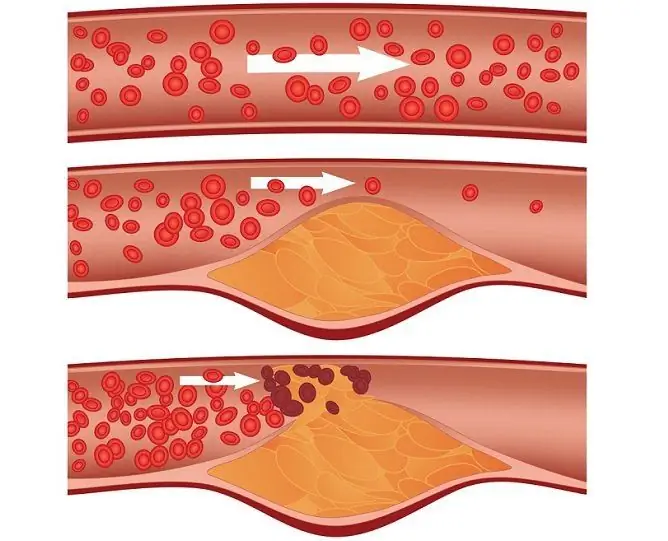- Author Rachel Wainwright [email protected].
- Public 2023-12-15 07:39.
- Last modified 2025-11-02 20:14.
Phimosis

Phimosis experts call the abnormal structure of the penis, which is expressed in a sharp narrowing of the foreskin, which prevents the opening of the head. The degree of release of the glans penis during phimosis can be different - from painful and laborious opening to complete adhesion of the foreskin to the skin of the glans.
The disease of phimosis in boys can be both congenital and acquired. The first case occurs most often and even has the name of the so-called physiological phimosis in children, which passes on its own by a certain age. Acquired phimosis can occur at any age and its cause, as a rule, lies in the previous inflammatory diseases of the penis or urethra, which led to a loss of elasticity and narrowing of the foreskin. Also a common cause of phimosis in adult men is mechanical trauma in the genital area.
The presence of phimosis at any age leads to various complications, both physiological and moral. First, the head of the penis, which is permanently closed by the foreskin, is a hotbed of chronic infection due to the accumulation of urine residues and secreted physiological secretions.
In addition, phimosis in adults inevitably causes psychological suffering, as it serves as a source of sexual disorders in men - from painful sensations during sexual intercourse with a partner to the complete impossibility of its implementation. Also, the lack of the necessary and timely treatment of phimosis in mature men leads them to the formation of various complexes and general neurotization.
Types of phimosis
1. Phimosis in children
In most cases, phimosis in children is diagnosed before the age of two to three years. As mentioned above, many experts call this condition physiological and argue that the treatment of phimosis in boys does not necessarily have to involve surgery.
Upon reaching the age of 6-7 years, phimosis in children, as a rule, goes away, and the head of the penis is released spontaneously. However, parents who decide to wait with the operation of phimosis until this age should be remembered about the obligatory observance of the hygiene of the genitals in the child - washing the head of the penis after each urination. In addition, with physiological phimosis in boys, experts recommend daily treatment of the area between the foreskin and the sensitive skin of the head with antiseptic solutions (chlorhexidine, miramistin, etc.) in order to prevent the accumulation of pathogens.
If, after the boy reaches seven years of age, there is no tendency to open the head of the penis, then we are definitely talking about a surgical operation of phimosis in a hospital.
2. Phimosis in adults
Cases of phimosis in adult men are quite common. The main reason for most of the diseases is the lack of treatment for congenital phimosis.
Sometimes the disease occurs unexpectedly during puberty of a young person. Due to a sharp hormonal surge, the genital organs develop rapidly with the formation of the foreskin and the head of the penis that do not match in size. Such phimosis in adults is less pronounced than a disease that has survived from childhood.
Phimosis degrees
Experts classify the disease with phimosis according to the degree of opening of the glans penis:
First degree. This degree of phimosis is characterized by the fact that at rest the head of the penis is easily freed from the foreskin. In order to move the foreskin in a state of erection, little effort is required.

Second degree. An erect penis is not released from the foreskin even with significant effort. At rest, the head is exposed freely, or with little difficulty.
Third degree. Attempts to stretch or move the foreskin from the glans penis while erect causes severe pain and tears with bleeding. At rest, with considerable effort, it is possible to free the head of the penis from the foreskin. There are no problems with urination with phimosis of this degree.
Fourth degree. The head of the penis is completely covered by the foreskin. At the beginning of urination, the prepuce (a bag of foreskin) swells, then urine is hardly excreted from a narrow opening in a thin stream or squeezed out in drops.
Phimosis reasons
The main reasons for the formation of phimosis have not yet been finally established, but experts are inclined to associate the disease with insufficient production of connective tissue by the body. Such a predisposition, as a rule, is of a genetic nature and often phimosis is accompanied by other malformations - heart valve pathologies, varicocele, flat feet and other abnormalities.
Phimosis treatment
Until recently, physicians attempted to treat phimosis with the help of medications (for example, hormonal agents). But the practical results of such treatment of phimosis did not bring the patient the long-awaited relief.
Today, the only and proven method of getting rid of the problem is circulation - a phimosis operation, which is a partial or complete circumcision of the foreskin.
Alternative treatments for phimosis, such as stretching the foreskin to release the glans penis, are not recommended for independent home use, especially in children.
YouTube video related to the article:
The information is generalized and provided for informational purposes only. At the first sign of illness, see your doctor. Self-medication is hazardous to health!






